Comprehensive Study about Effect of Basalt Fiber, Gradation, Nominal Maximum Aggregate Size and Asphalt on the Anti-Cracking Ability of Asphalt Mixtures
Abstract
1. Introduction
2. Experimental Study
2.1. Materials and Mixture Design
2.1.1. Asphalt
2.1.2. Basalt Fiber
2.1.3. Lignin Fiber
2.1.4. Mixture Design
2.2. Test Method
2.2.1. IDEAL Test
2.2.2. SCB Test
2.2.3. SEM Test
3. Results and Discussion
3.1. IDEAL Test
3.1.1. Effect of Basalt Fiber on the IDEAL Test Result
3.1.2. Effect of Gradation Type on the IDEAL Test Result
3.1.3. Effect of NMAS on the IDEAL Test Result
3.1.4. Effect of Asphalt Type on the IDEAL Test Result
3.2. SCB Test
3.2.1. Effect of Basalt Fiber on the SCB Test Result
3.2.2. Effect of Gradation Type on the SCB Test Result
3.2.3. Effect of NMAS on the SCB Test Result
3.2.4. Effect of Asphalt Type on the SCB Test Result
3.3. Correlation Analysis between the Test Result Indexes of SCB and IDEAL Tests
4. Conclusions
- Basalt fiber can well enhance the initial cracking resistance and the crack propagation rate of different asphalt mixtures.
- The cracking resistance and crack propagation speed of SMA mixture is better than that of SUP mixture.
- Nominal maximum aggregate size is negatively correlated with the cracking resistance of asphalt mixtures.
- SBS modified asphalt has better reinforcing effect on the cracking resistance of asphalt mixtures and it can better slow down the crack propagation rate than pure asphalt.
- The FI value and the CTindex were more sensitive to the change of the test samples. There is a good correlation between CTindex of IDEAL test and FI value of SCB test.
Author Contributions
Funding
Institutional Review Board Statement
Informed Consent Statement
Data Availability Statement
Acknowledgments
Conflicts of Interest
References
- Nwakaire, C.M.; Yap, S.P.; Yuen, C.W.; Onn, C.C.; Koting, S.; Babalghaith, A.M. Laboratory study on recycled concrete ag-gregate based asphalt mixtures for sustainable flexible pavement surfacing. J. Clean. Prod. 2020, 262, 121462. [Google Scholar] [CrossRef]
- Liu, P.; Chen, J.; Lu, G.; Wang, D.; Oeser, M.; Leischner, S. Numerical Simulation of Crack Propagation in Flexible Asphalt Pavements Based on Cohesive Zone Model Developed from Asphalt Mixtures. Materials 2019, 12, 1278. [Google Scholar] [CrossRef]
- Badeli, S.; Solatiyan, E.; Carter, A.; Eng, P. Flexible Warm Mix Asphalt for Rural Roads in Canada—Laboratory Results and Case Studies; Canadian Technical Asphalt Association: Montreal, QC, Canada, 2019. [Google Scholar]
- Li, C.; Wang, L.; Wang, X.-X. Crack and crack growth behavior analysis of asphalt mixtures based on the digital speckle correlation method. Constr. Build. Mater. 2017, 147, 227–238. [Google Scholar] [CrossRef]
- Kringos, N.; Scarpas, A. Raveling of asphaltic mixes due to water damage: Computational identification of controlling parame-ters. Transp. Res. Rec. 2005, 1929, 79–87. [Google Scholar] [CrossRef]
- Xiao, F.; Li, R.; Amirkhanian, S.; Yuan, J. Rutting-Resistance Investigation of Alternative Polymerized Asphalt Mixtures. J. Mater. Civ. Eng. 2018, 30, 04018116. [Google Scholar] [CrossRef]
- Akentuna, M.; Kim, S.S.; Nazzal, M.; Abbas, A.R.; Arefin, M.S. Study of the thermal stress development of asphalt mixtures using the Asphalt Con-crete Cracking Device (ACCD). Constr. Build. Mater. 2016, 114, 416–422. [Google Scholar] [CrossRef]
- Tabatabaee, H.A.; Velasquez, R.; Bahia, H.U. Modeling thermal stress in asphalt mixtures undergoing glass transition and phys-ical hardening. Transp. Res. Rec. 2012, 2296, 106–114. [Google Scholar] [CrossRef]
- Cong, L.; Peng, J.; Guo, Z.; Wang, Q. Evaluation of Fatigue Cracking in Asphalt Mixtures Based on Surface Energy. J. Mater. Civ. Eng. 2017, 29, 4015003. [Google Scholar] [CrossRef]
- Lv, S.; Hu, L.; Xia, C.; Wang, X.; Cabrera, M.B.; Guo, S.; Chen, J. Development of fatigue damage model of asphalt mixtures based on small-scale accelerated pave-ment test. Constr. Build. Mater. 2020, 260, 119930. [Google Scholar] [CrossRef]
- Hou, Y.; Wang, L.; Pauli, T.; Sun, W. Investigation of the Asphalt Self-Healing Mechanism Using a Phase-Field Model. J. Mater. Civ. Eng. 2015, 27, 04014118. [Google Scholar] [CrossRef]
- Hou, Y.; Sun, W.; Das, P.; Song, X.; Wang, L.; Ge, Z.; Huang, Y. Coupled Navier–Stokes phase-field model to evaluate the microscopic phase separation in as-phalt binder under thermal loading. J. Mater. Civ. Eng. 2016, 28, 04016100. [Google Scholar] [CrossRef]
- Ziari, H.; Aliha, M.R.; Moniri, A.; Saghafi, Y. Crack resistance of hot mix asphalt containing different percentages of reclaimed as-phalt pavement and glass fiber. Constr. Build. Mater. 2020, 230, 117015. [Google Scholar] [CrossRef]
- Liang, H.; Wang, D.; Shi, L.; Liang, X.; Tang, C. Use of digital images for fracture performance evaluation of asphalt mixtures. Constr. Build. Mater. 2020, 253, 119152. [Google Scholar] [CrossRef]
- Zegeye, E.; Le, J.-L.; Turos, M.; Marasteanu, M. Investigation of size effect in asphalt mixture fracture testing at low temperature. Road Mater. Pavement Des. 2012, 13, 88–101. [Google Scholar] [CrossRef]
- Vamegh, M.; Ameri, M.; Naeni, S.F.C. Performance evaluation of fatigue resistance of asphalt mixtures modified by SBR/PP polymer blends and SBS. Constr. Build. Mater. 2019, 209, 202–214. [Google Scholar] [CrossRef]
- Jaskuła, P.; Stienss, M.; Szydłowski, C. Effect of Polymer Fibres Reinforcement on Selected Properties of Asphalt Mixtures. Procedia Eng. 2017, 172, 441–448. [Google Scholar] [CrossRef]
- Zarei, A.; Zarei, M.; Janmohammadi, O. Evaluation of the Effect of Lignin and Glass Fiber on the Technical Properties of Asphalt Mixtures. Arab. J. Sci. Eng. 2019, 44, 4085–4094. [Google Scholar] [CrossRef]
- Wang, W.; Cheng, Y.; Ma, G.; Tan, G.; Sun, X.; Yang, S. Further Investigation on Damage Model of Eco-Friendly Basalt Fiber Modified Asphalt Mixture under Freeze-Thaw Cycles. Appl. Sci. 2018, 9, 60. [Google Scholar] [CrossRef]
- Kou, C.; Wu, X.; Xiao, P.; Liu, Y.; Wu, Z. Physical, Rheological, and Morphological Properties of Asphalt Reinforced by Basalt Fiber and Lignin Fiber. Materials 2020, 13, 2520. [Google Scholar] [CrossRef]
- Wang, D.; Wang, L.; Gu, X.; Zhou, G. Effect of basalt fiber on the bitumen binder and mastic at low temperature. J. Mater. Civ. Eng. 2013, 25, 355–364. [Google Scholar] [CrossRef]
- Li, Z.; Shen, A.; Wang, H.; Guo, Y.; Wu, H. Effect of basalt fiber on the low-temperature performance of a bitumen mixture in a heavily frozen area. Constr. Build. Mater. 2020, 253, 119080. [Google Scholar] [CrossRef]
- Zhao, H.; Guan, B.; Xiong, R.; Zhang, A. Investigation of the performance of basalt fibre reinforced bitumen mixture. Appl. Sci. 2020, 10, 1561. [Google Scholar] [CrossRef]
- Yan, C.; Zhang, Y.; Bahia, H.U. Comparison between SCB-IFIT, un-notched SCB-IFIT and IDEAL-CT for measuring cracking resistance of asphalt mixtures. Constr. Build. Mater. 2020, 252, 119060. [Google Scholar] [CrossRef]
- Zhao, Y.; Ni, F.; Zhou, L.; Jiang, J. Heterogeneous fracture simulation of asphalt mixture under SCB test with cohesive crack model. Road Mater. Pavement Des. 2017, 18, 1411–1422. [Google Scholar] [CrossRef]
- Zhou, F.; Im, S.; Sun, L.; Scullion, T. Development of an IDEAL cracking test for asphalt mix design and QC/QA. Road Mater. Pavement Des. 2017, 18, 405–427. [Google Scholar] [CrossRef]
- Mohammad, L.N.; Kim, M.; Elseifi, M. Characterization of asphalt mixture’s fracture resistance using the semi-circular bending (SCB) test. In Proceedings of the 7th RILEM International Conference on Cracking in Pavements, Dordrecht, The Netherlands, 20–22 June 2012; Springer: Dordrecht, The Netherlands, 2012; pp. 1–10. [Google Scholar]
- Wang, J.; Yuan, J.; Xiao, F.; Li, Z.; Wang, J.; Xu, Z. Performance investigation and sustainability evaluation of multiple-polymer asphalt mixtures in airfield pavement. J. Clean. Prod. 2018, 189, 67–77. [Google Scholar] [CrossRef]
- Gao, J.; Liu, P.; Wu, Y.; Xu, Y.; Lu, H. Moisture damage of asphalt mixture and its evaluation under the long-term soaked duration. Int. J. Pavement Res. Technol. 2021, 14, 607–614. [Google Scholar] [CrossRef]
- Lou, K.; Xiao, P.; Kang, A.; Wu, Z.; Lu, P. Suitability of Fiber Lengths for Hot Mix Asphalt with Different Nominal Maximum Aggregate Size: A Pilot Experimental Investigation. Materials 2020, 13, 3685. [Google Scholar] [CrossRef] [PubMed]
- Occupation Standard of the People’s Republic of China. Technical Specification for Construction of Highway Asphalt Pavement; JTG F40; Occupation Standard of the People’s Republic of China: Beijing, China, 2004. [Google Scholar]
- Jiangsu Bureau of Quality and Technical Supervision. Standard Specification for Superpave Construction; DS32/T 2798; Jiangsu Bureau of Quality and Technical Supervision: Nanjing, China, 2015. [Google Scholar]
- Shi, L.; Wang, D.; Xiao, X.; Qin, X. Meso-structural characteristics of asphalt mixture main skeleton based on meso-scale analysis. Constr. Build. Mater. 2020, 232, 117263. [Google Scholar] [CrossRef]
- Chen, H.; Xu, Q.; Chen, S.; Zhang, Z. Evaluation and design of fiber-reinforced asphalt mixtures. Mater. Des. 2009, 30, 2595–2603. [Google Scholar] [CrossRef]
- Hu, J.; Qian, Z.; Liu, Y.; Xue, Y. Microstructural characteristics of asphalt concrete with different gradations by X-ray CT. J. Wuhan Univ. Technol. Sci. Ed. 2017, 32, 625–632. [Google Scholar] [CrossRef]
- Singh, H.; Chopra, T.; Jain, S.; Kaur, A.; Kamotra, S. Effect of aggregate type and polymer modification on the performance of bituminous concrete mixes. Int. J. Appl. Sci. Eng. 2019, 16, 1–13. [Google Scholar]
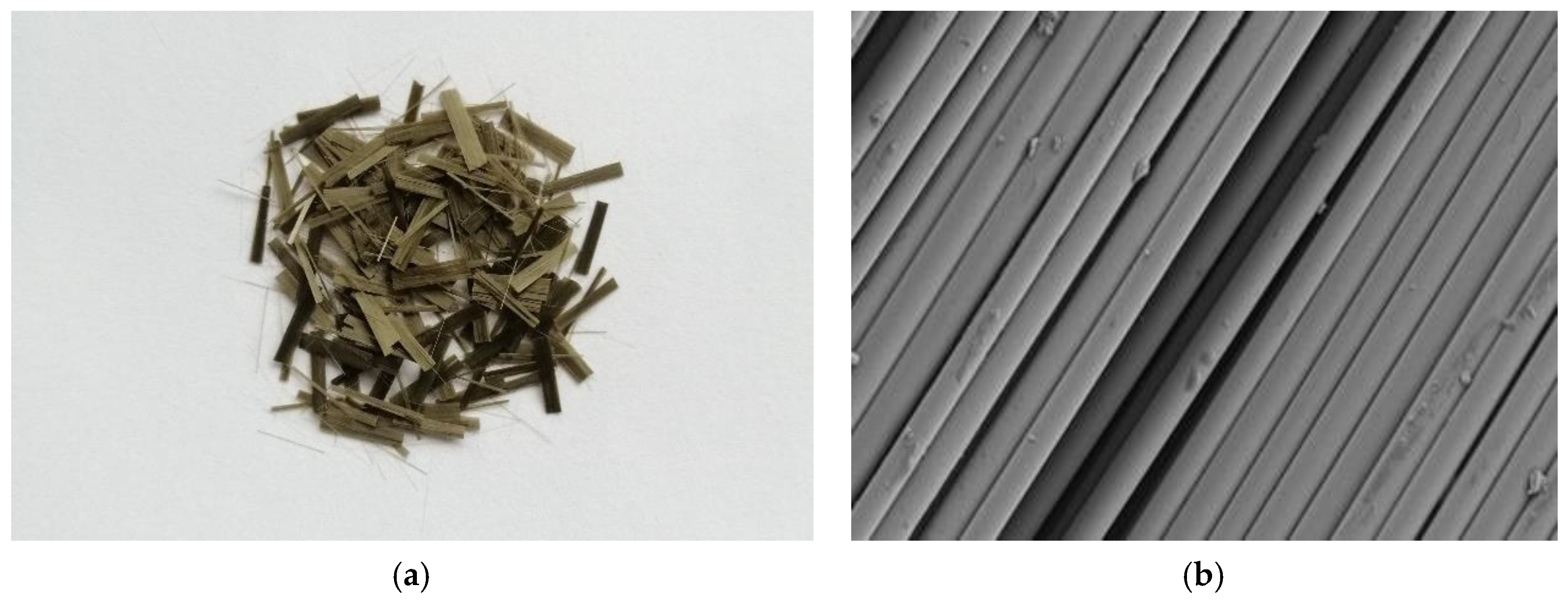
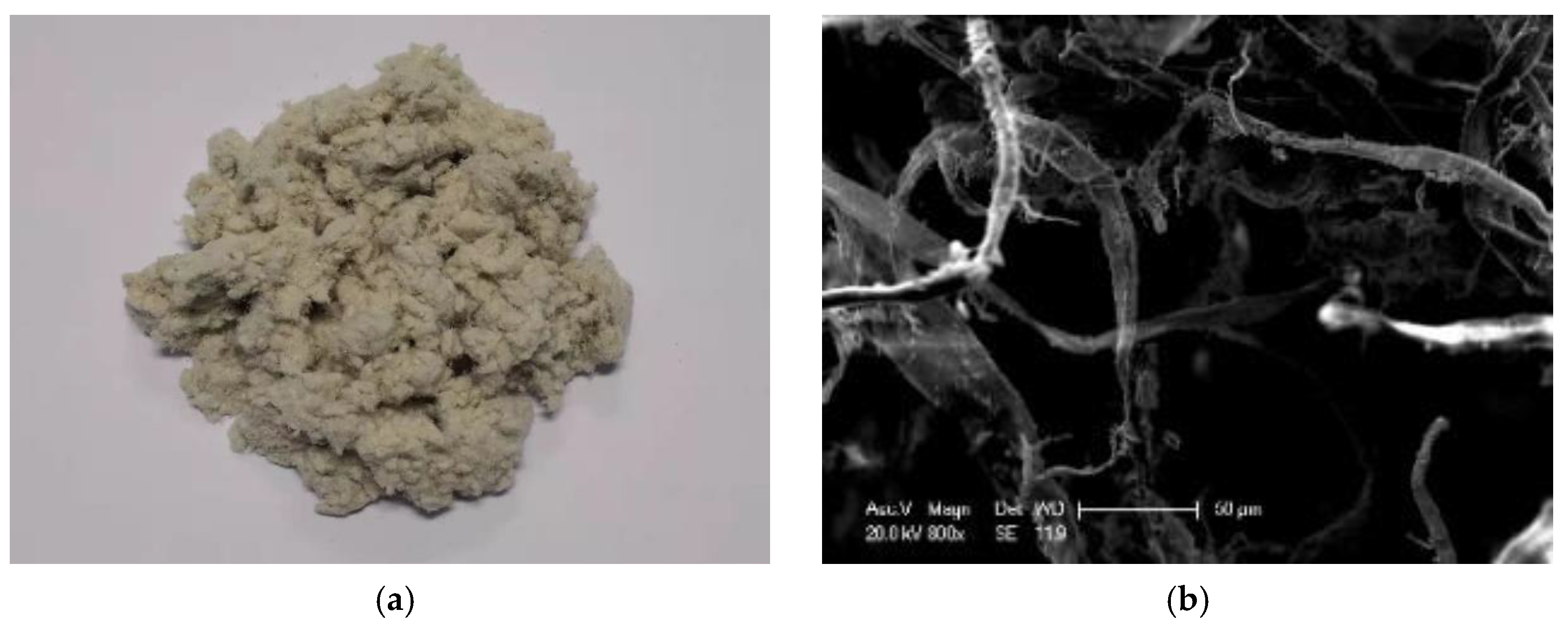
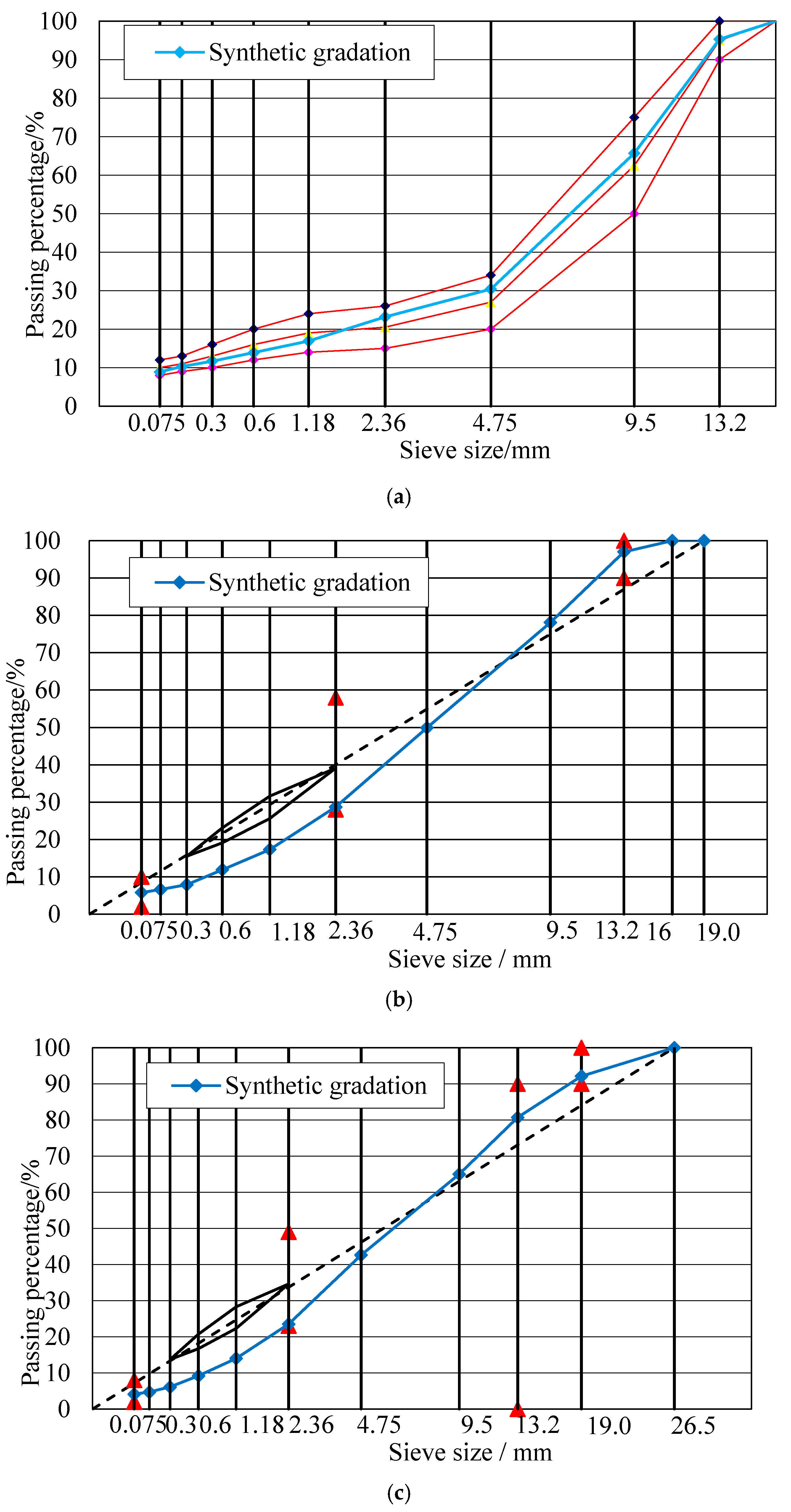
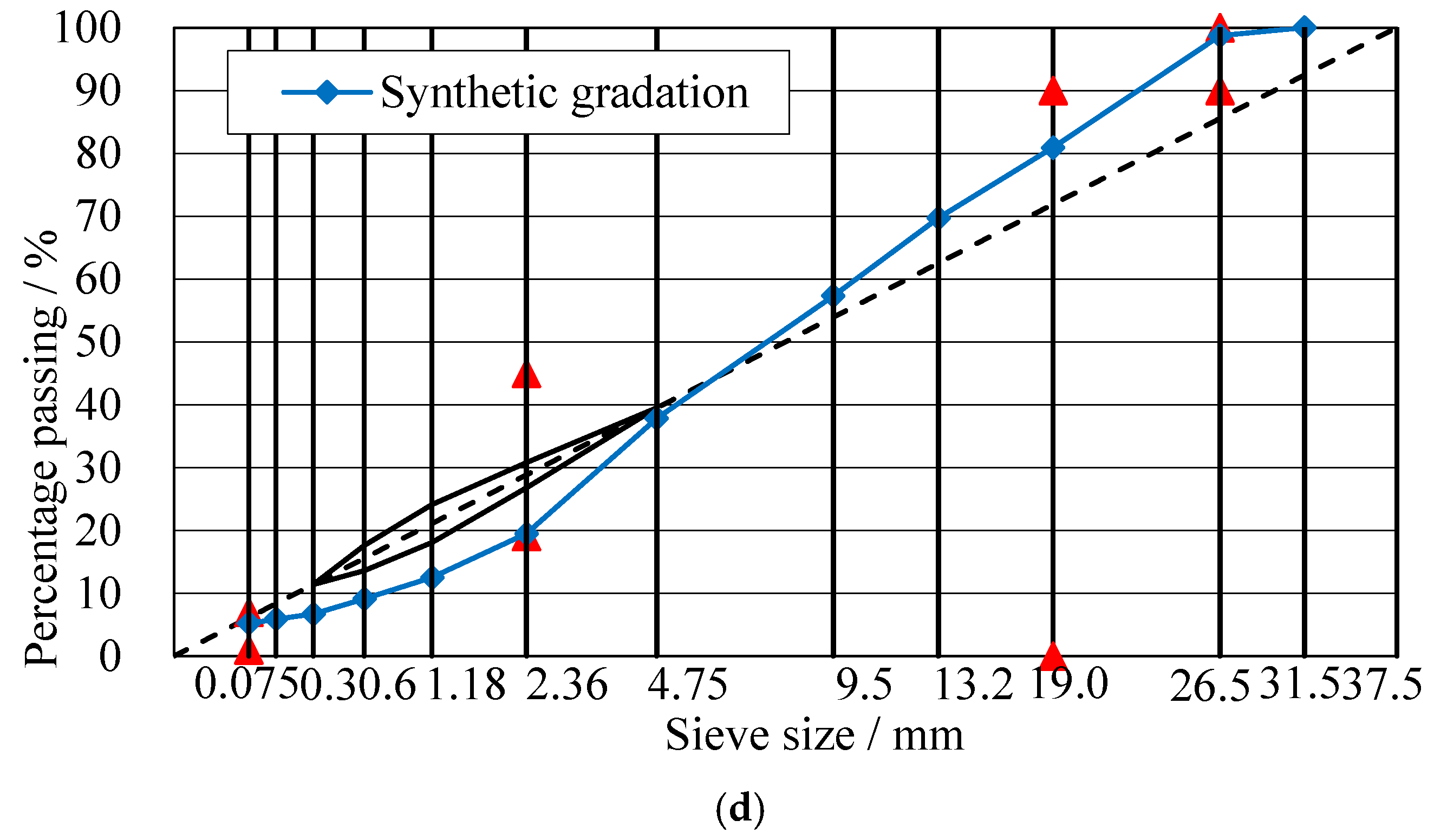
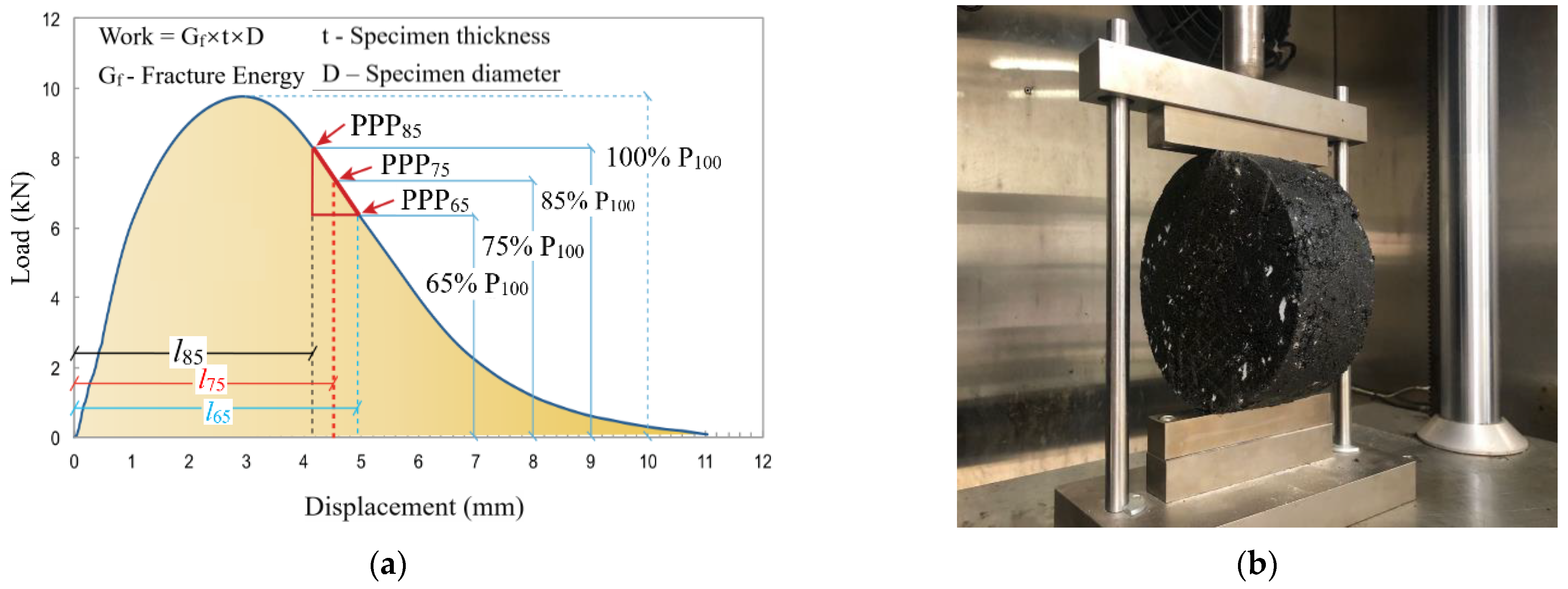

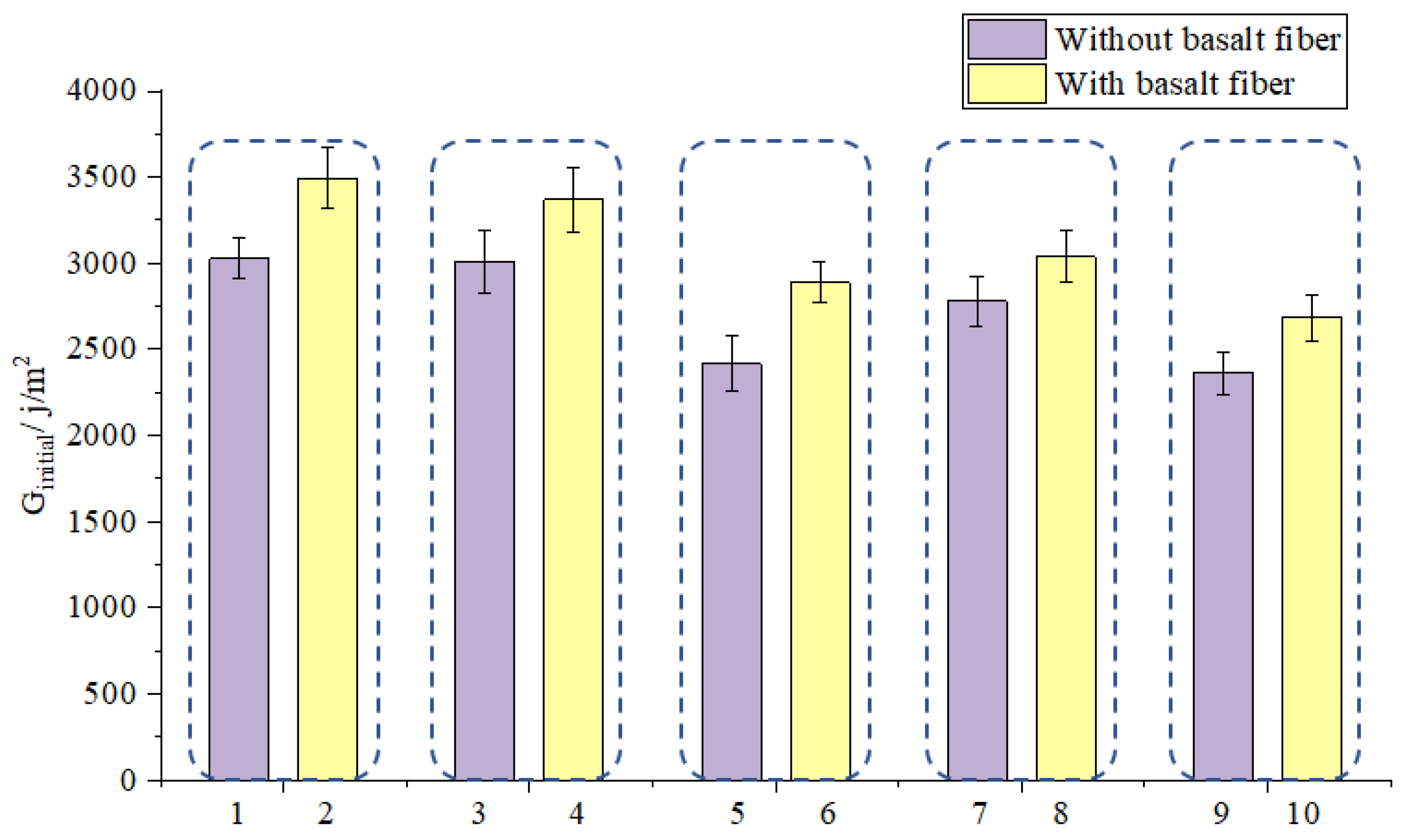
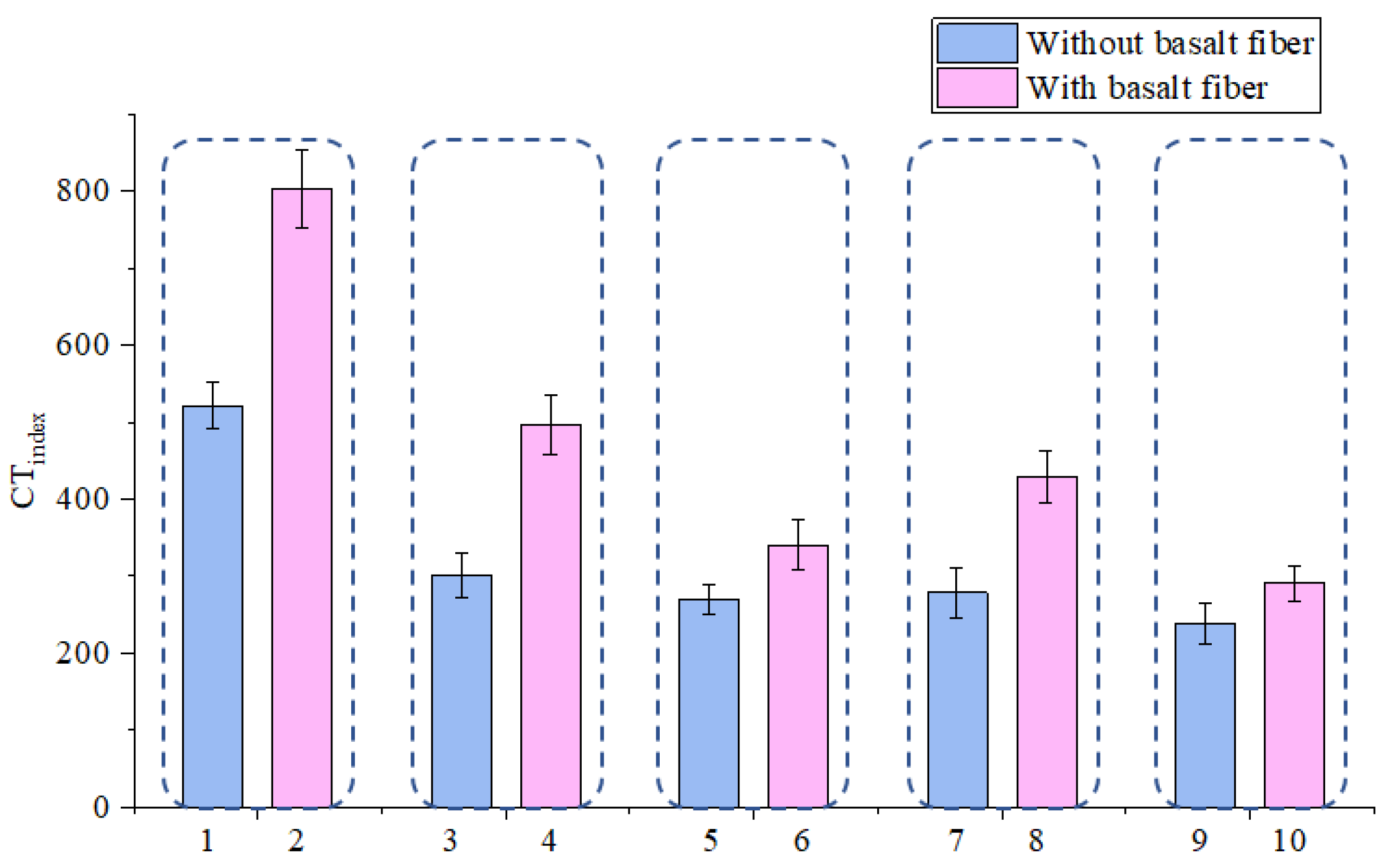
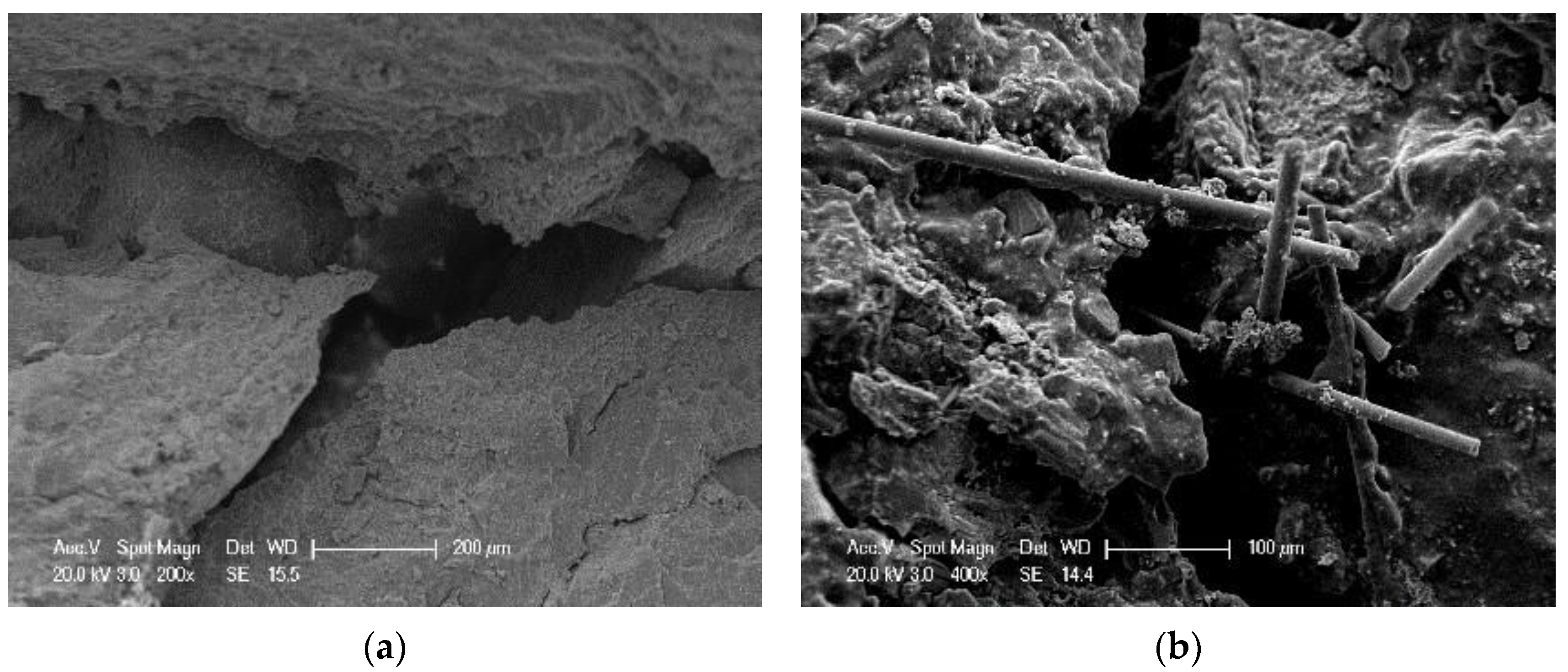
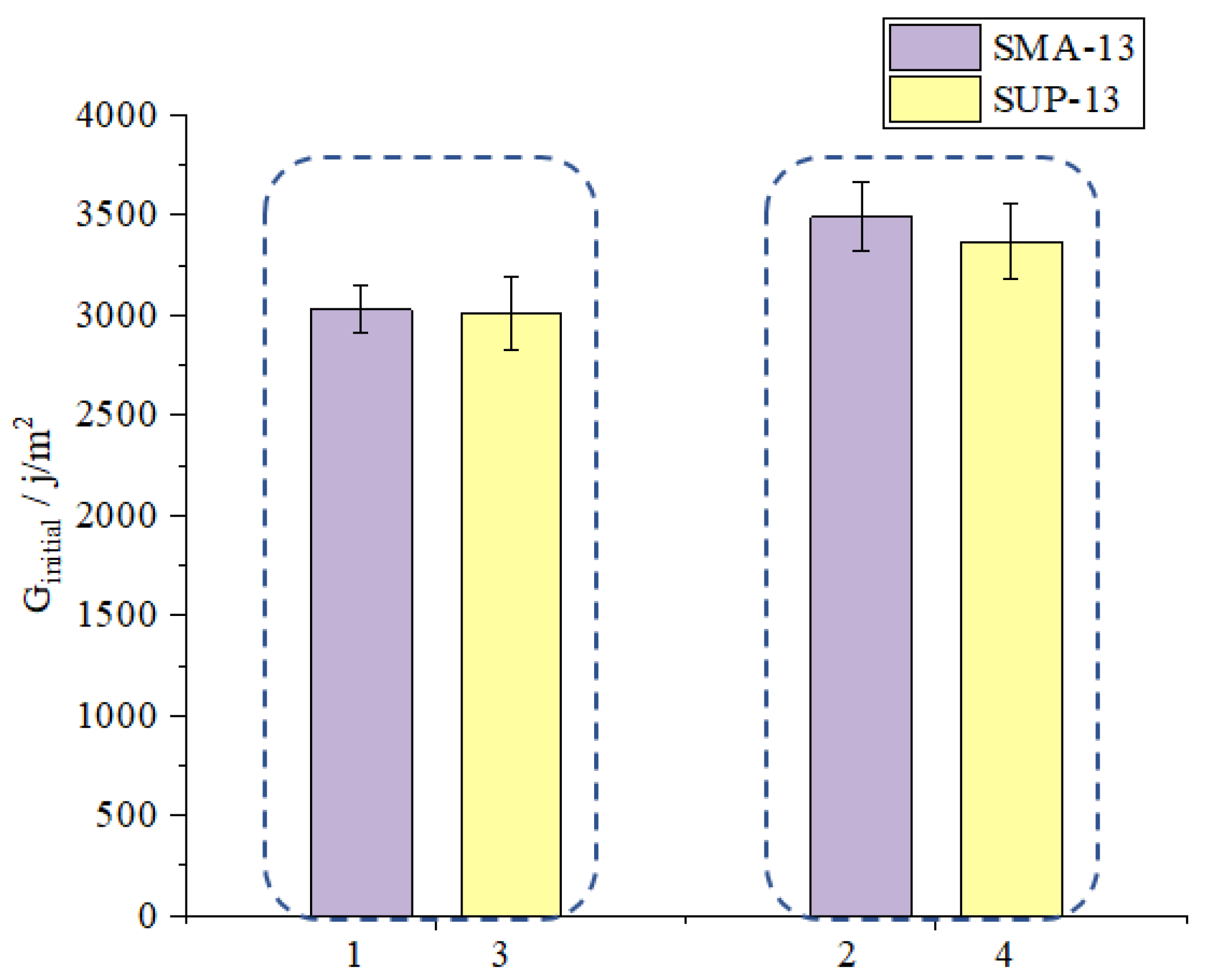
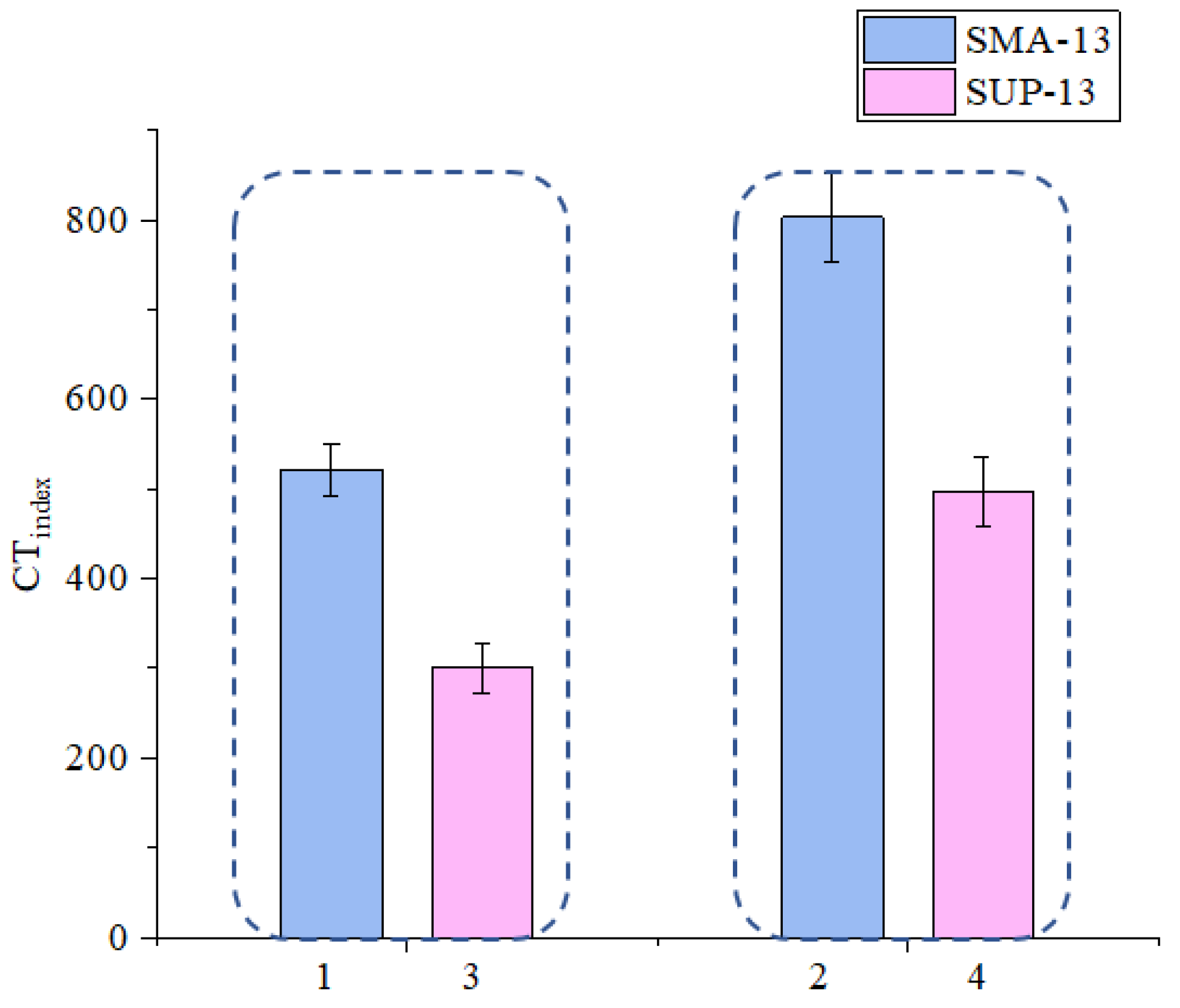
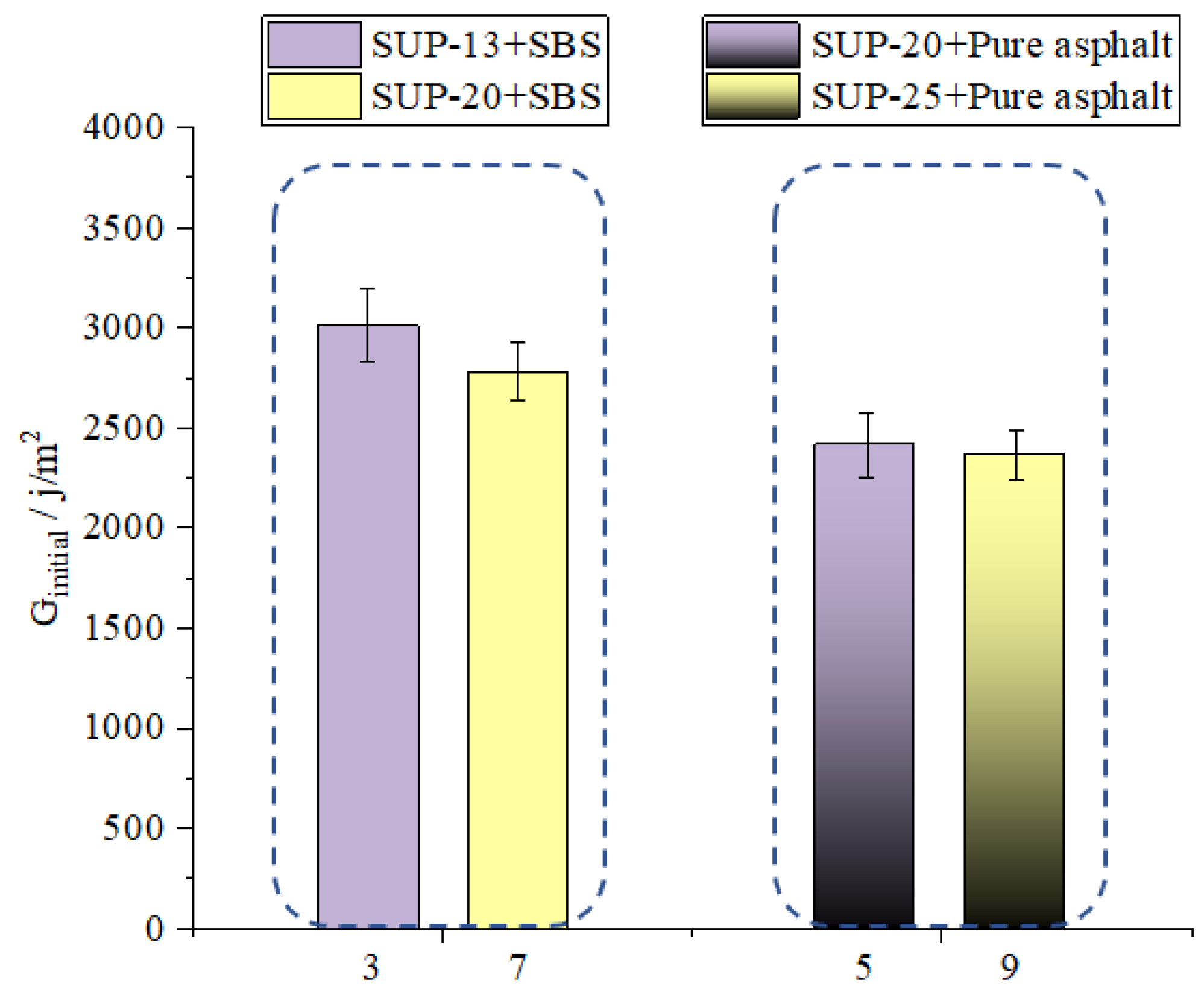
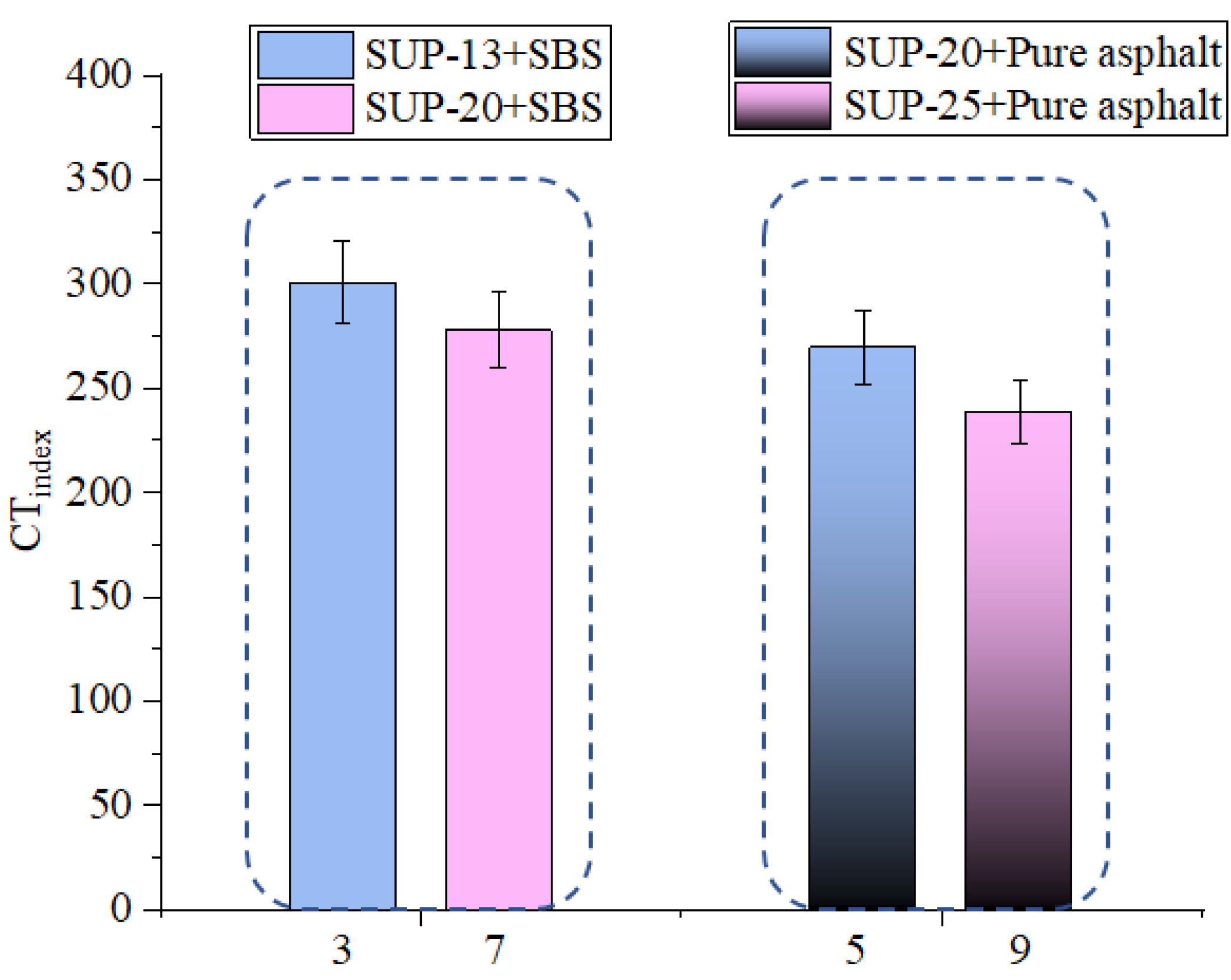
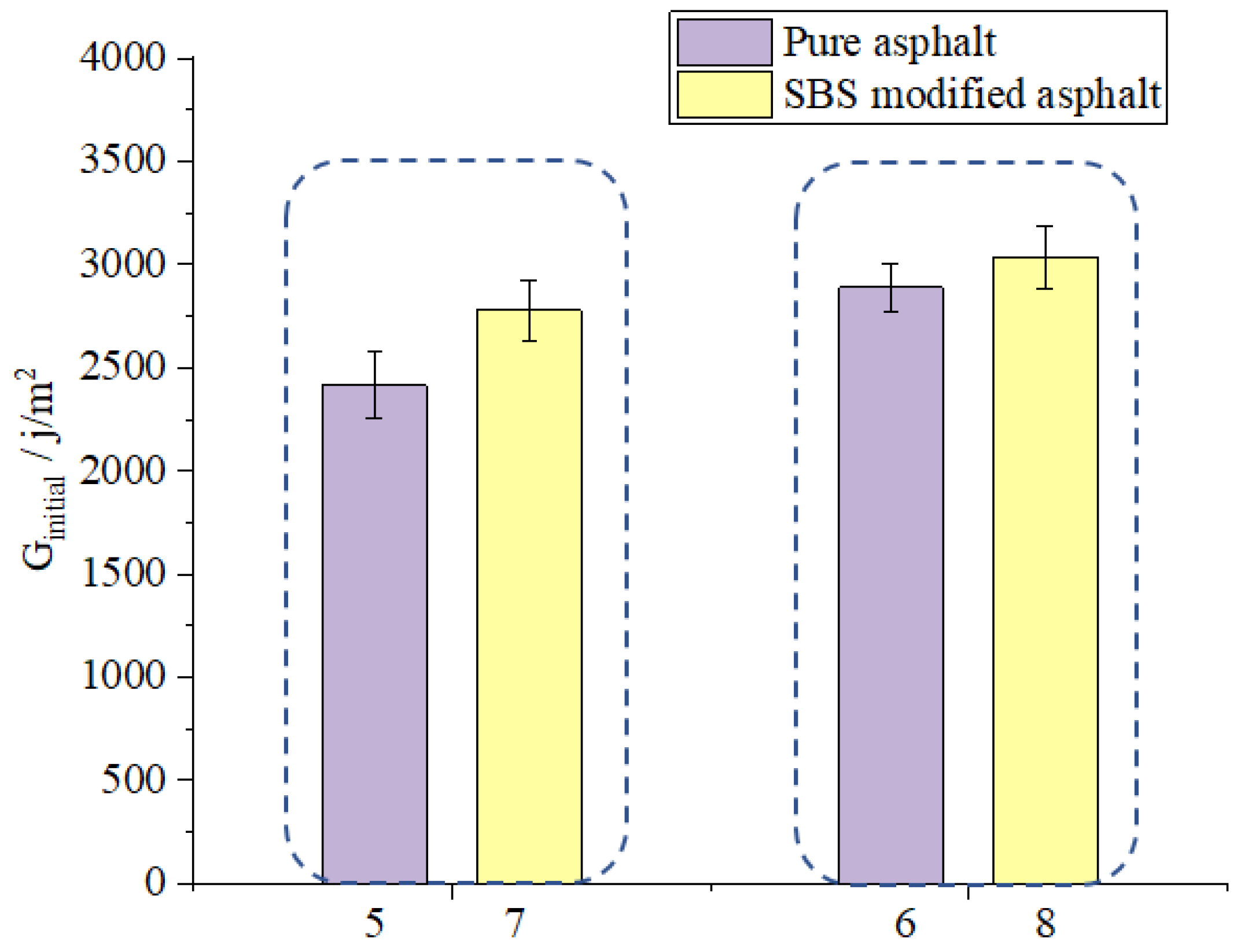
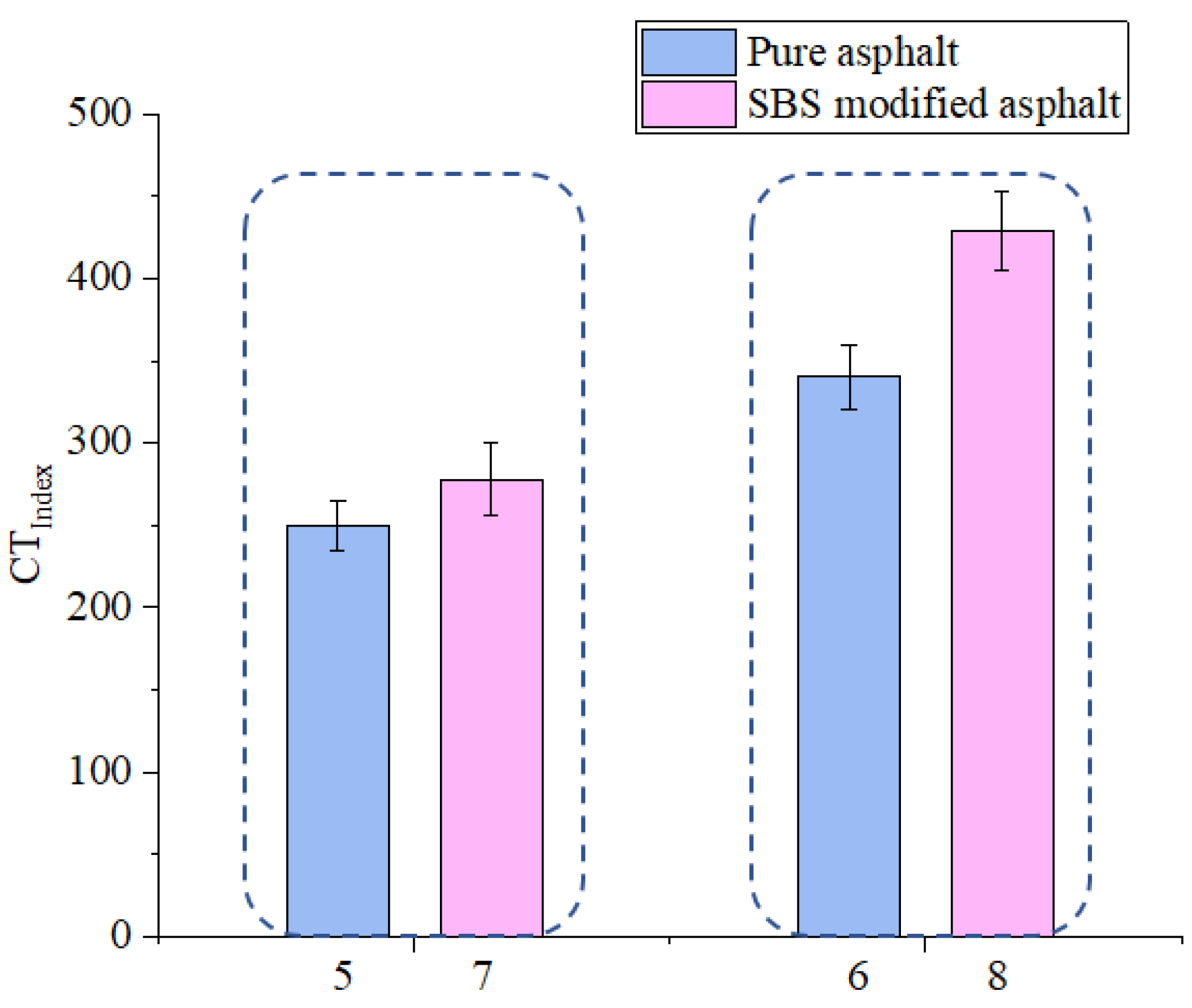
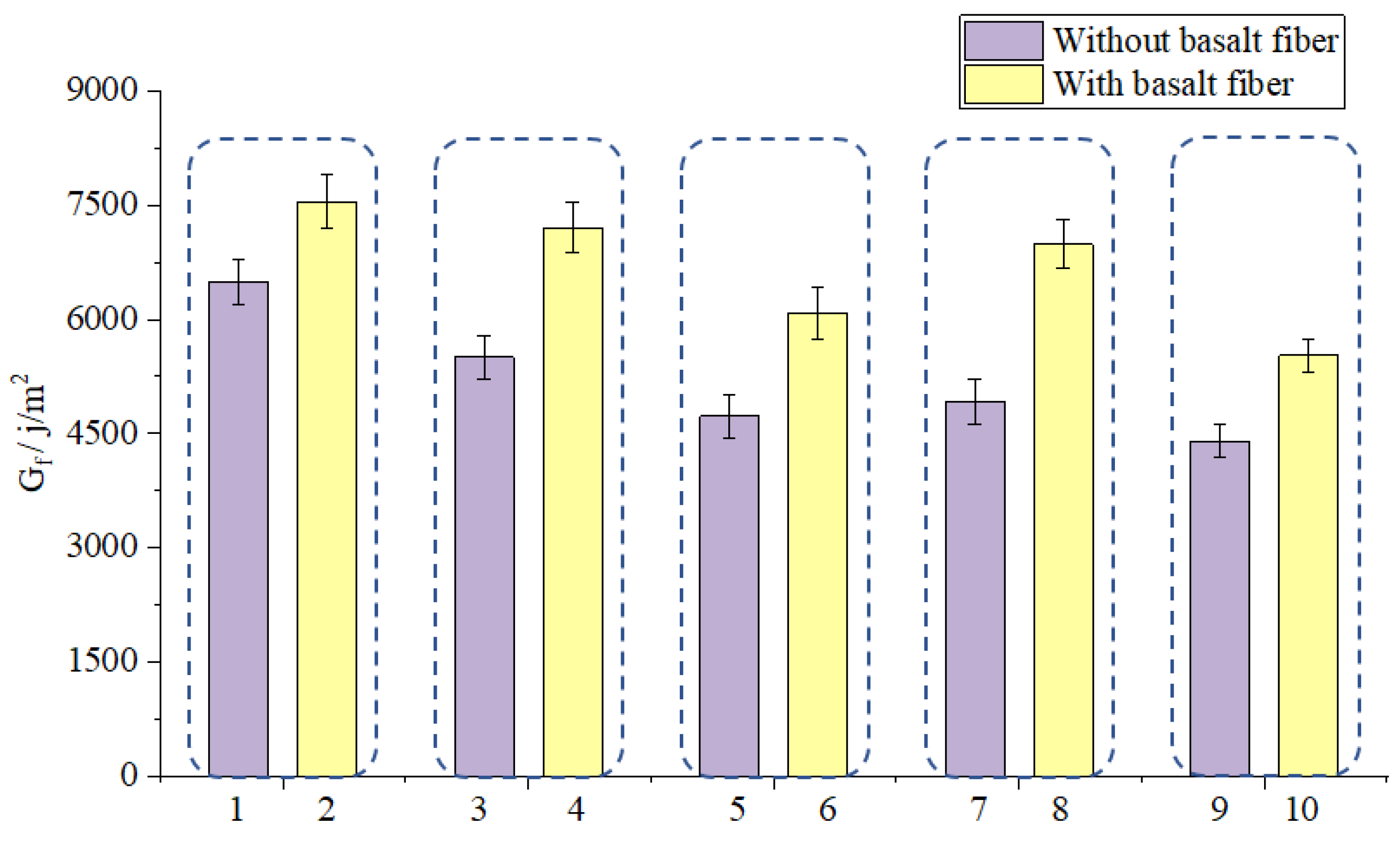
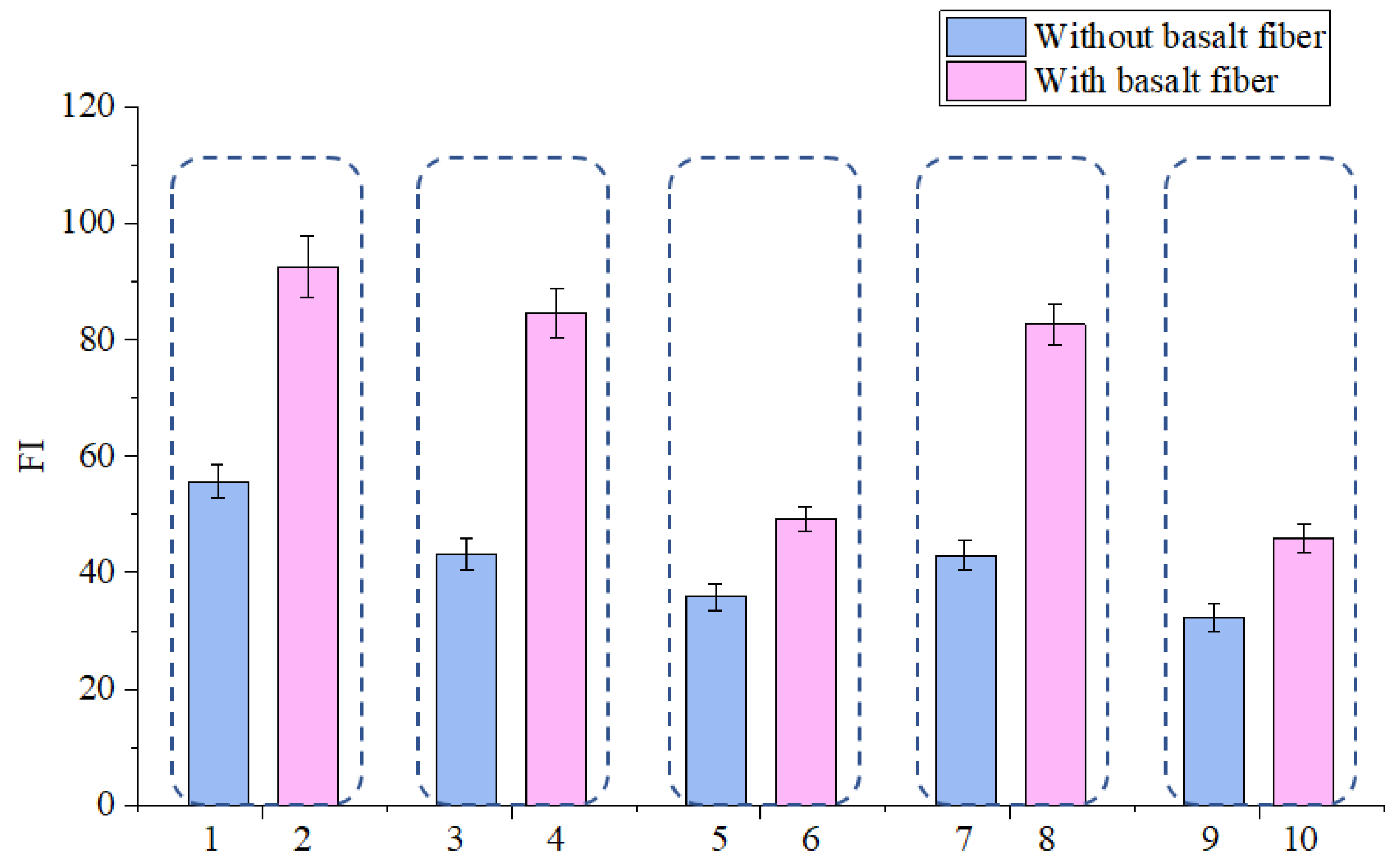
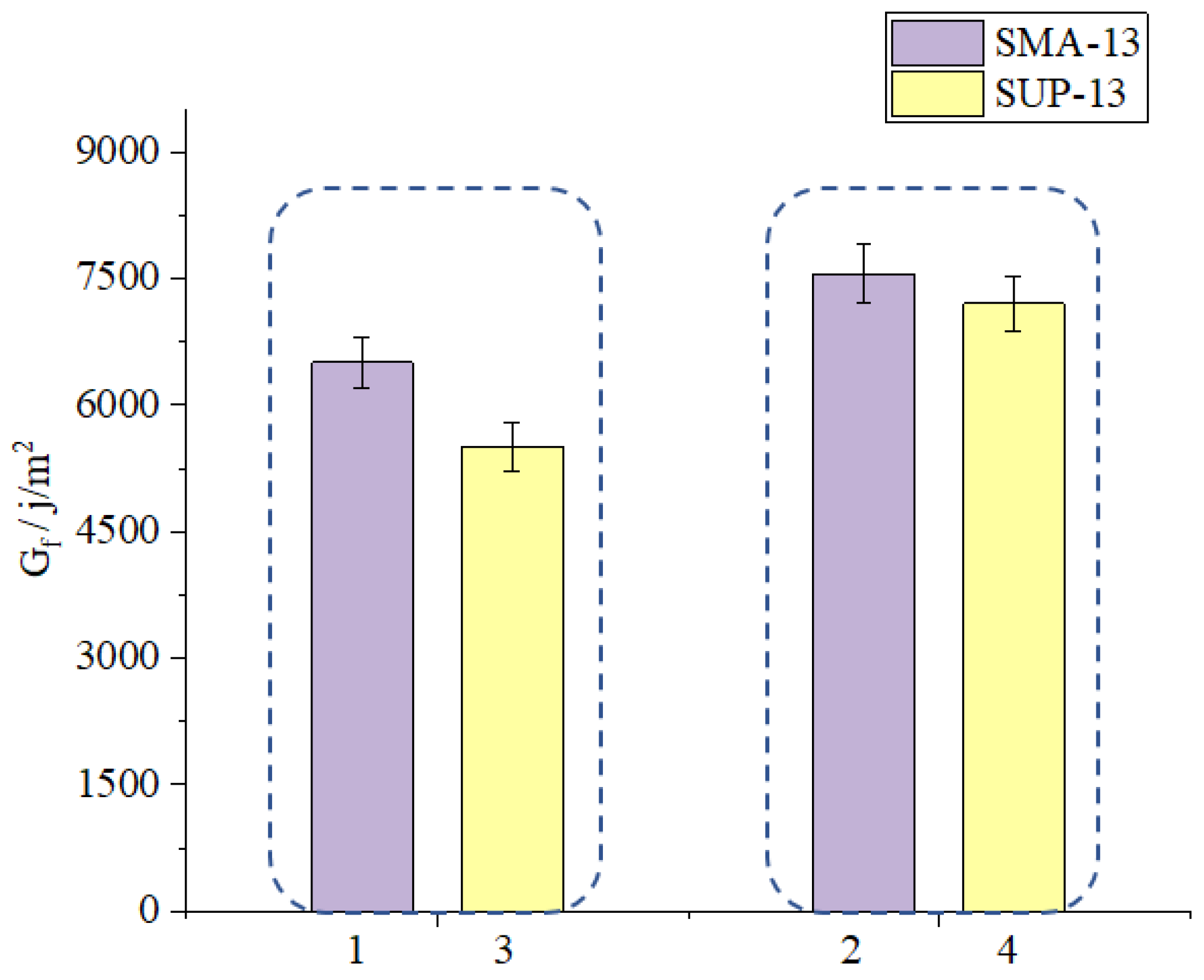
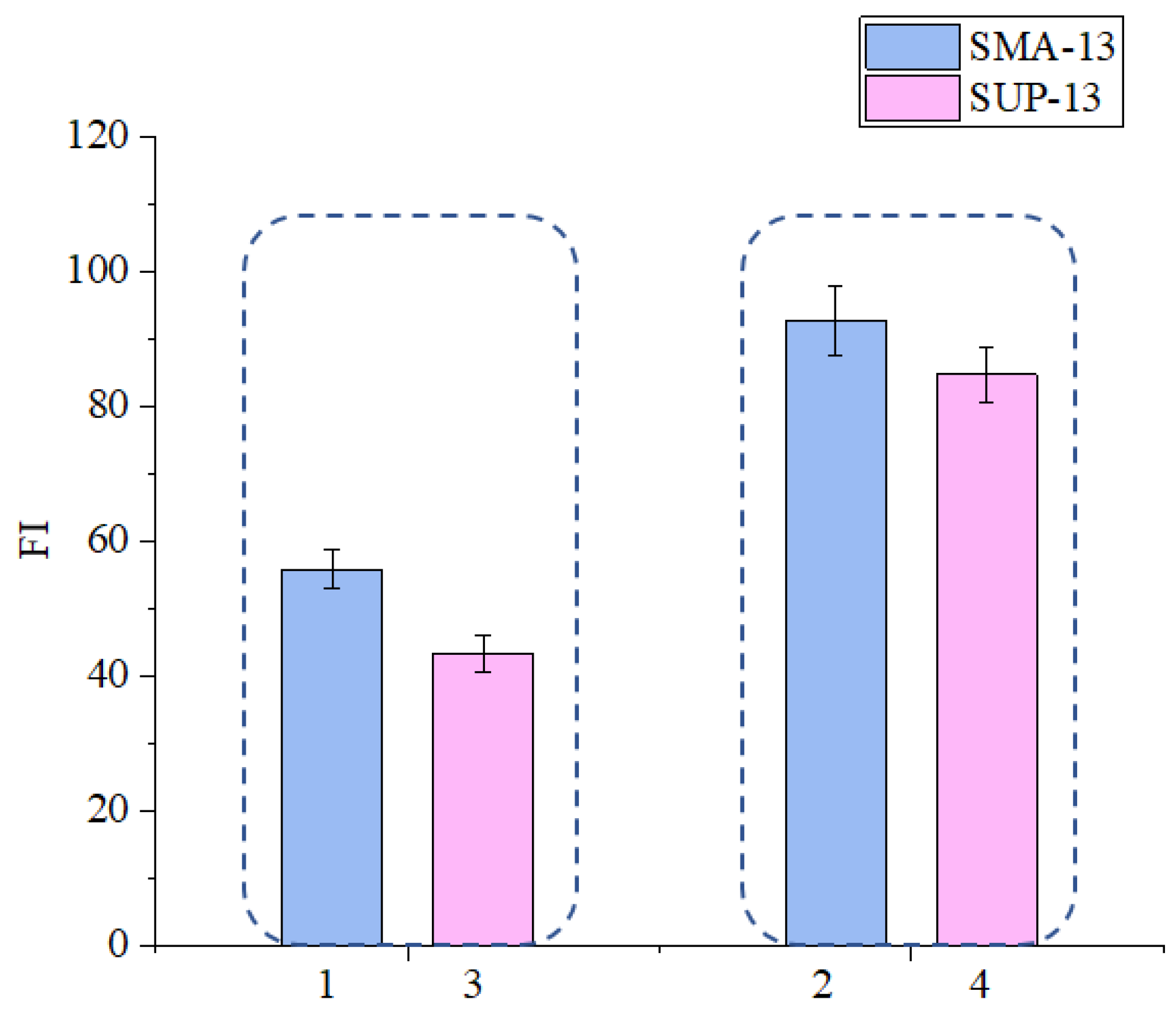

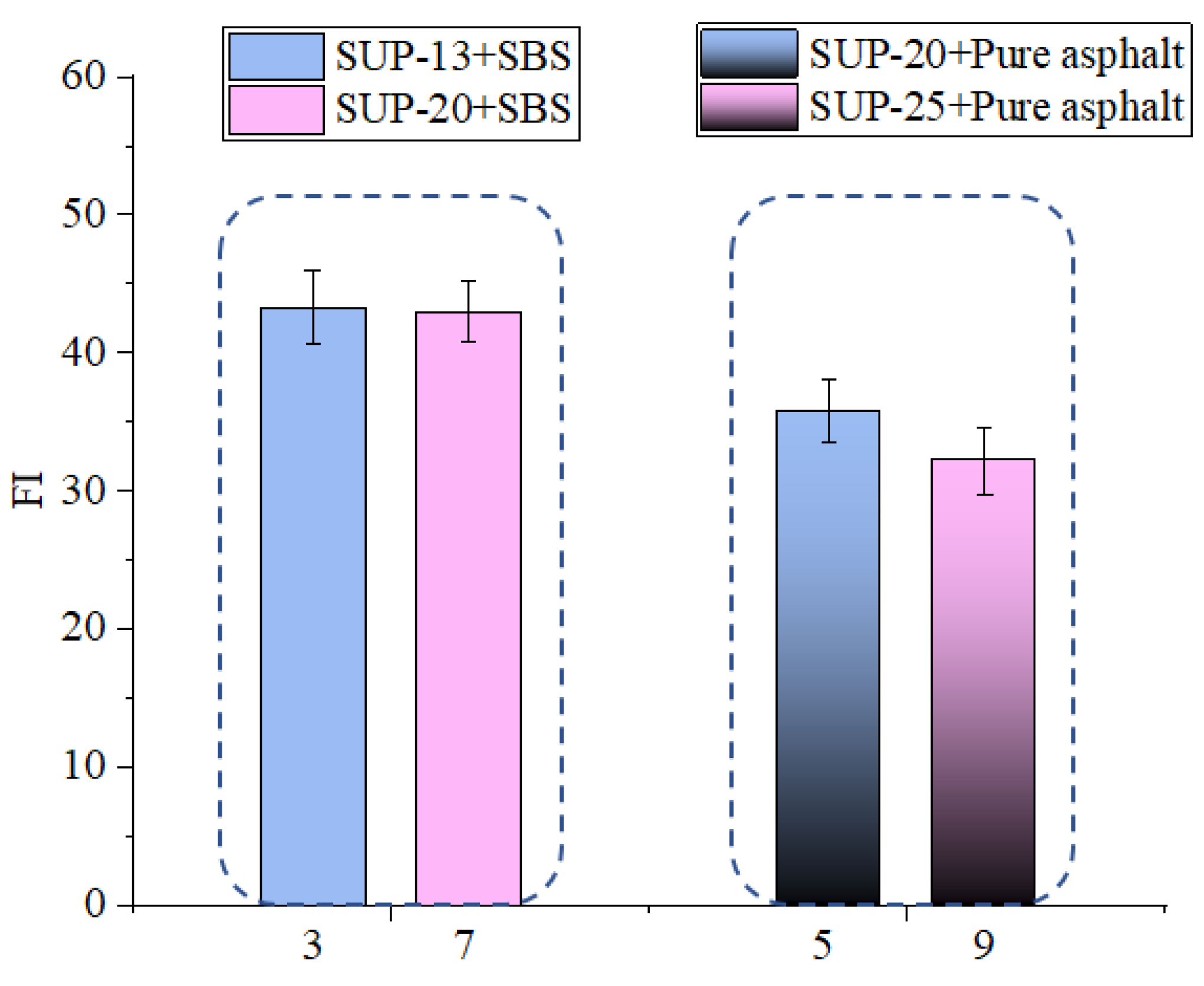
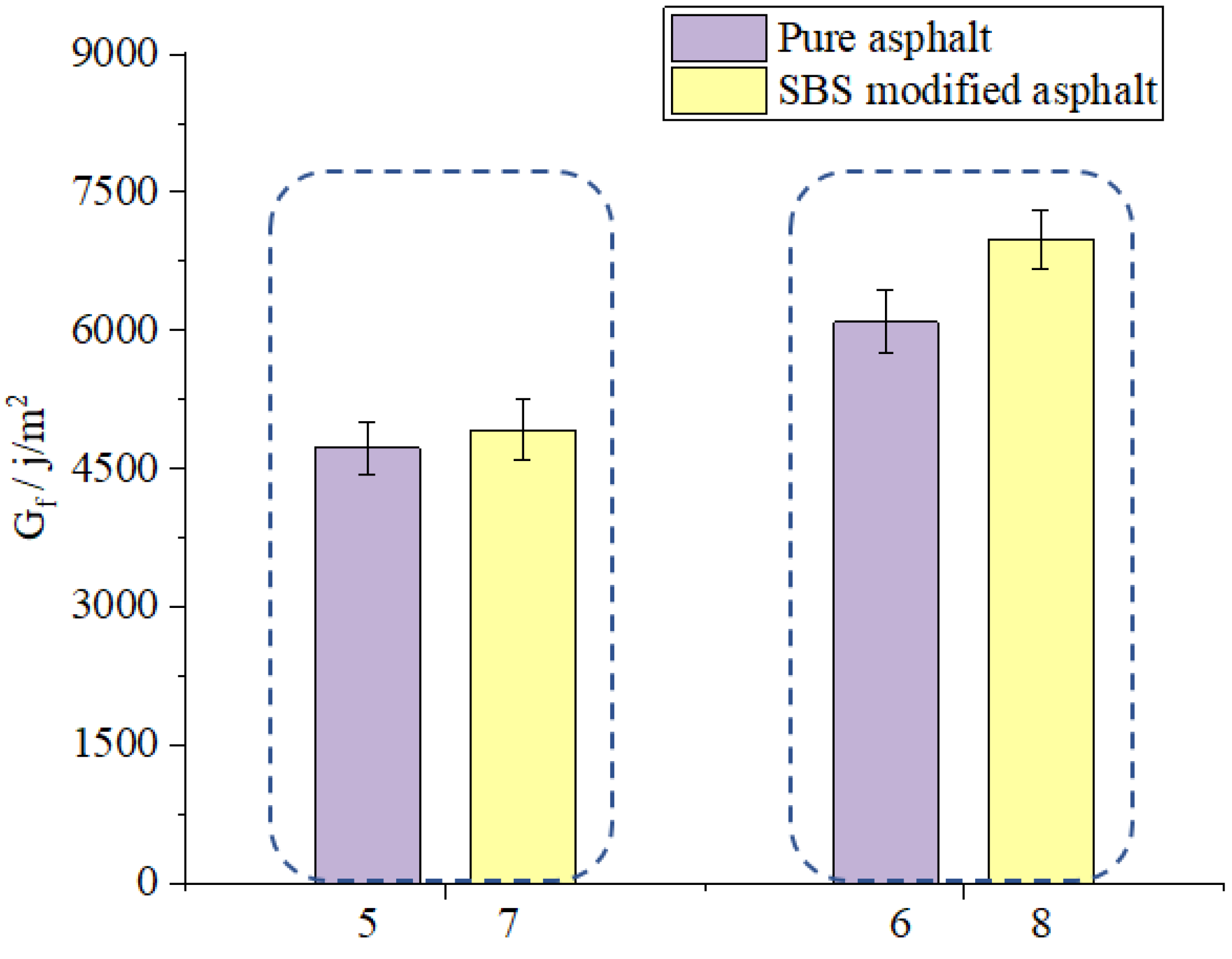

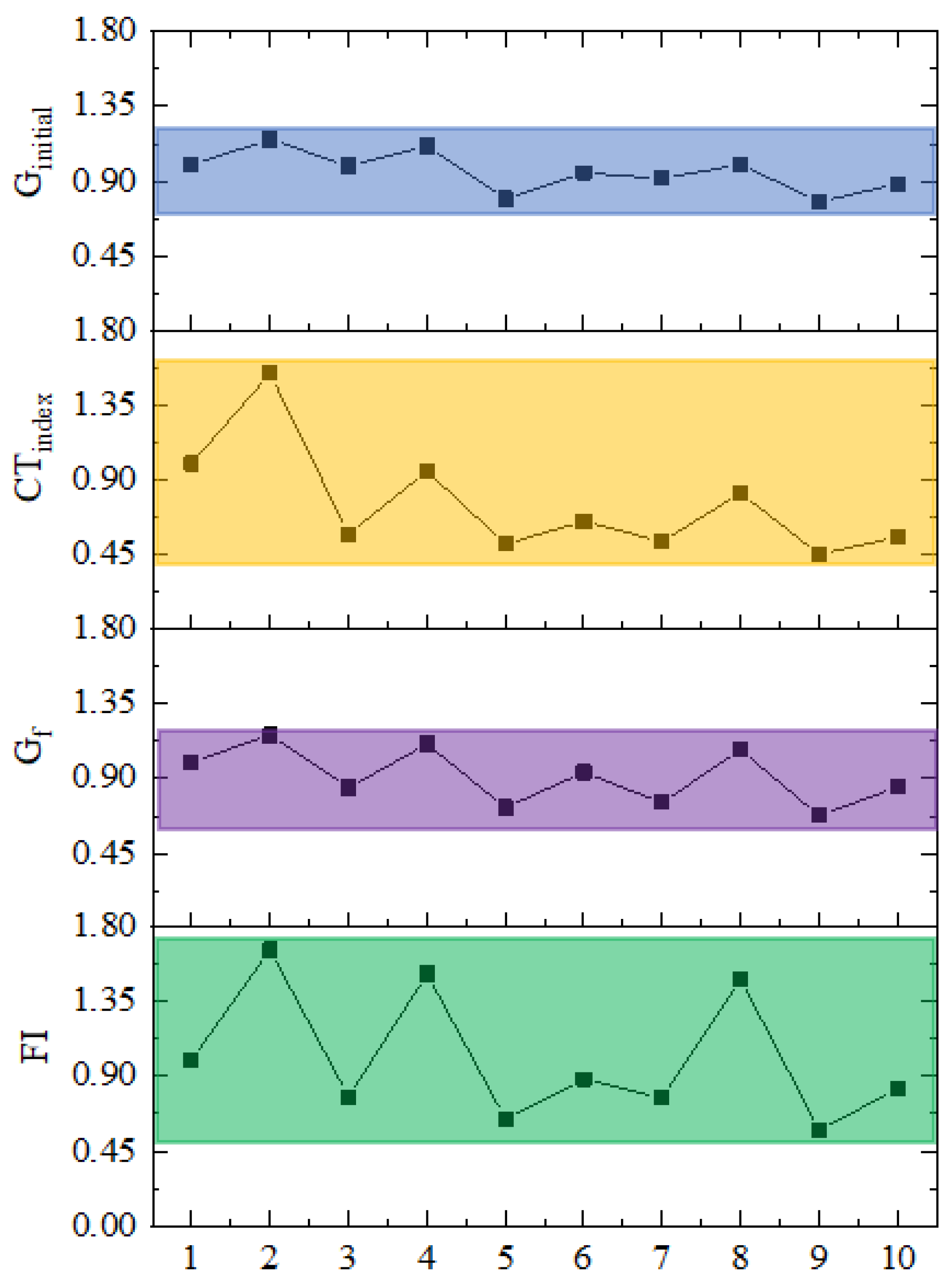

| Index | Asphalt | Value |
|---|---|---|
| Penetration (25 °C, 100 g, 5 s), 0.1 mm | Pure asphalt | 62 |
| SBS modified asphalt | 71 | |
| Penetration index (PI) | Pure asphalt | −0.12 |
| SBS modified asphalt | 0.5 | |
| Softening point (TR and B), °C | Pure asphalt | 48.5 |
| SBS modified asphalt | 64 | |
| Ductility (15 °C/5 °C, 5 cm/min), cm | Pure asphalt | >100 |
| SBS modified asphalt | 48 |
| Index | Specific Surface Area (m2/g) | Hygroscopic Rate (%) | Heat Resistance (°C) | pH Value | Fracture Strength (MPa) |
|---|---|---|---|---|---|
| Basalt fiber | 0.15 | 1.63 | 1550 | 7.1 | ≥2000 |
| Index | Specific Surface Area (m2/g) | Hygroscopic Rate (%) | Heat Resistance (°C) | pH Value |
|---|---|---|---|---|
| Lignin fiber | 1.82 | 6.2 | 260 | 7.7 |
| Code | Gradation | Asphalt Type | Fiber Additive | Fiber Content/% | Optimum Asphalt Content/% |
|---|---|---|---|---|---|
| 1 | SMA-13 | SBS modified asphalt | Lignin fiber | 0.3% | 6.1 |
| 2 | SMA-13 | SBS modified asphalt | Basalt fiber | 0.3% | 5.9 |
| 3 | SUP-13 | SBS modified asphalt | / | / | 5.3 |
| 4 | SUP-13 | SBS modified asphalt | Basalt fiber | 0.3% | 5.5 |
| 5 | SUP-20 | Pure asphalt | / | / | 4.3 |
| 6 | SUP-20 | Pure asphalt | Basalt fiber | 0.3% | 4.5 |
| 7 | SUP-20 | SBS modified asphalt | / | / | 4.3 |
| 8 | SUP-20 | SBS modified asphalt | Basalt fiber | 0.3% | 4.5 |
| 9 | SUP-25 | Pure asphalt | / | / | 4.2 |
| 10 | SUP-25 | Pure asphalt | Basalt fiber | 0.3% | 4.4 |
Publisher’s Note: MDPI stays neutral with regard to jurisdictional claims in published maps and institutional affiliations. |
© 2021 by the authors. Licensee MDPI, Basel, Switzerland. This article is an open access article distributed under the terms and conditions of the Creative Commons Attribution (CC BY) license (http://creativecommons.org/licenses/by/4.0/).
Share and Cite
Lou, K.; Wu, X.; Xiao, P.; Kang, A.; Wu, Z.; Xia, Y. Comprehensive Study about Effect of Basalt Fiber, Gradation, Nominal Maximum Aggregate Size and Asphalt on the Anti-Cracking Ability of Asphalt Mixtures. Appl. Sci. 2021, 11, 2289. https://doi.org/10.3390/app11052289
Lou K, Wu X, Xiao P, Kang A, Wu Z, Xia Y. Comprehensive Study about Effect of Basalt Fiber, Gradation, Nominal Maximum Aggregate Size and Asphalt on the Anti-Cracking Ability of Asphalt Mixtures. Applied Sciences. 2021; 11(5):2289. https://doi.org/10.3390/app11052289
Chicago/Turabian StyleLou, Keke, Xing Wu, Peng Xiao, Aihong Kang, Zhengguang Wu, and Yan Xia. 2021. "Comprehensive Study about Effect of Basalt Fiber, Gradation, Nominal Maximum Aggregate Size and Asphalt on the Anti-Cracking Ability of Asphalt Mixtures" Applied Sciences 11, no. 5: 2289. https://doi.org/10.3390/app11052289
APA StyleLou, K., Wu, X., Xiao, P., Kang, A., Wu, Z., & Xia, Y. (2021). Comprehensive Study about Effect of Basalt Fiber, Gradation, Nominal Maximum Aggregate Size and Asphalt on the Anti-Cracking Ability of Asphalt Mixtures. Applied Sciences, 11(5), 2289. https://doi.org/10.3390/app11052289





